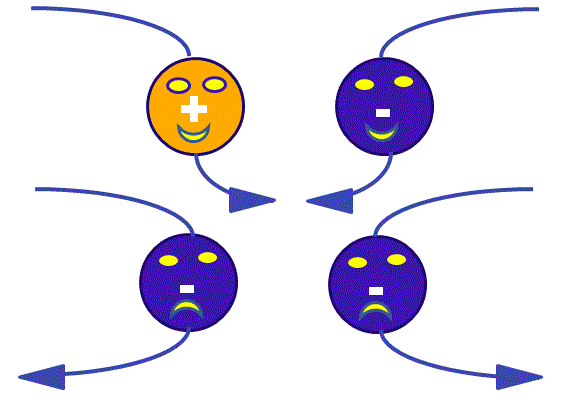During the winter, have you ever rubbed your feet on a carpet and touched a metal object--like a doorknob? What did you feel? What did you see? Most likely you felt a shock and you may have seen a bright spark. That shock occurred because you developed a
charge. Like charges repel each other, while opposite charges attract each other.
 |
| Two negative (-) charges repel each other. Two positive (+) charges repel each other. A positive (+) and negative (-) charge attract each other. |
This is where the phrase "opposites attract" comes from. For convenience sake, we call one type of charge positive (+) and the other negative (-) (Thank you Benjamin Franklin!).
Electrons carry a negative charge.
When you rubbed your feet on the carpet, electrons from the carpet stuck to you, leaving positive charge behind on the carpet. Charge cannot spread out well on the carpet (it's a material property--caused by what is in the carpet). The situation when unbalanced charge is stuck somewhere, is called static electricity.
 |
| Static electricity makes the positive charge on the carpet stay there. You also develop a charge that, when it isn't moving, is also static electricity. Electrons, which carry negative charge, are more easily removed from materials than positive charge. |
Electrons are so tiny that they can't be seen with your eye. Your body can conduct charge (charge can spread out on your body) somewhat well. The movement of charge is called
Current. When you touched the metal object, the charge moved from you to the metal object (a current flowed), since the metal object had less negative charge than you did, shocking you. Confusingly, even though it is electrons that move, the flow of current is described with respect to positive charges. If electrons are going to the right, current is said to flow to the left. Electrons do not like to be next to each other, although this becomes less important when positive charges are around.
 |
| Current is defined with respect to positive charges, so to get the total current, you add together the current from positive and negative charges if negative and positive charges are moving in opposite directions. If they are moving in the same direction, subtract the negative current from the positive current. If you just have positive charges, the current is in the direction the positive charges are moving. If you just have negative charges, the current is opposite the direction the negative charges are moving. |
You felt a shock and not a gradual loss of charge because metals conduct charge (electricity) well. Consider a metal as a highway and your body as like a neighborhood street. If your parents tried to drive as fast on a highway as on a neighborhood street, they would get into an accident and be slowed down. However, they can safely move at those speeds on the highway and move places much faster. When the charge on your body meets the metal super-highway for charge, the extra electrons from the carpet quickly move from your body to the metal.
One fun experiment that you can do to see static electricity in action is to blow up a balloon and rub it on your hair. The balloon gets electrons from your hair. Next, stick the balloon to a wall. It sticks! Also, your hair might stand up on its ends and you'll end up looking like this.
The electrons on the balloon repel the electrons on the wall, which also doesn't conduct well, allowing it to stick. Notice that, after a while, the balloon falls. Just because something doesn't conduct well, it doesn't mean that it doesn't conduct at all.





No comments:
Post a Comment